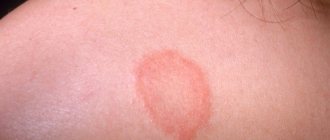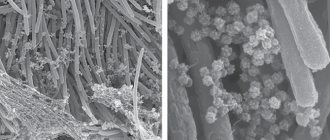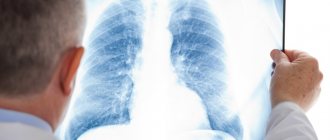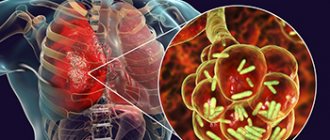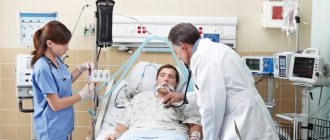Author:
Akulkina Larisa Anatolyevna pulmonologist
Quick transition Treatment of idiopathic interstitial pneumonia
Idiopathic interstitial pneumonia (IIP) is a group of diffuse inflammatory and/or fibrotic lung diseases, united on the basis of similar clinical, radiological and histological signs, leading to a decrease in lung volumes and the development of respiratory failure.
Forms and complications
The main clinical and radiological forms of IIP, previously combined into a single group of “fibrosing alveolitis”, include:
- idiopathic pulmonary fibrosis;
- nonspecific interstitial pneumonia;
- cryptogenic organizing pneumonia;
- desquamative interstitial pneumonia;
- respiratory bronchiolitis associated with interstitial lung disease;
- lymphocytic interstitial pneumonia;
- idiopathic pleuroparenchymal fibroelastosis;
- acute interstitial pneumonia.
General symptoms
General symptoms characteristic of interstitial pneumonia:
- fever;
- chills;
- moist cough;
- stuffy nose;
- tachypnea (sometimes this is just one symptom);
- breathing with whistling and grunting sounds;
- when inhaling, a noticeable increase in enlargement of the nostrils, abdominal breathing or muscle movement between the ribs;
- vomit;
- diarrhea;
- chest pain;
- abdominal pain, which often occurs because the child is coughing and trying to breathe through the entire abdominal wall;
- decreased activity;
- loss of appetite (in older children) or decreased food intake (in infants), which can lead to dehydration;
- in extreme cases, bluish or grayish color of lips and nails.
Good to know! If the inflammatory process is in the lower part of the lungs close to the abdominal cavity, the child will have fever, abdominal pain, vomiting, but will not have problems breathing.
Children with pneumonia caused by bacteria usually become critically ill quickly, beginning with a sudden rise in temperature and abnormally rapid breathing. Babies with pneumonia caused by viruses are likely to have symptoms that begin gradually and are quite mild, although wheezing is likely to be more common.
Features in newborns
Newborns and infants may not show pathognomonic signs (directly indicating the disease) of pneumonia infection. It is incredibly difficult to know if babies have a condition because they do not have developed speech to communicate how they are feeling.
Clinical picture of the pathological process in the lungs of newborn infants:
- sad look;
- cries more than before;
- eats little;
- irritability;
- vomit;
- grunt.
The best way to find out for sure whether a child has pneumonia is to consult a pediatrician.
A pediatrician or general practitioner can check for serous effusion or pus in your child's lungs using percussion, a stethoscope, or imaging techniques.
By paying attention to the symptoms of the early stages of interstitial pneumonia in children, parents have a chance that their child will bypass the emergency department. However, pneumonia can develop very quickly among children (especially infants) with underlying health conditions.
Causes of the disease
Idiopathic interstitial pneumonia is classified as a disease with an unspecified etiology. For a number of IIPs (in particular, idiopathic pulmonary fibrosis), genetic predisposition plays a significant role. Cryptogenic organizing pneumonia often develops after respiratory infections (bacterial, viral), including after the new coronavirus infection COVID-19. Respiratory bronchiolitis, associated with interstitial lung disease, develops more often in people who smoke.
Rehabilitation after pneumonia
For prolonged polysegmental pneumonia and persistent bronchospastic syndrome, glucocorticosteroids are used. Doctors at the Yusupov Hospital prescribe these drugs in small doses for a short course (7-10 days). To improve sputum discharge, bronchodilators and mucolytics are used. Patients take them orally or in the form of ultrasonic inhalations.
After normalization of body temperature, patients are given physiotherapeutic procedures and massage. Physical therapy helps improve the drainage function of the bronchi. Patients begin to do breathing exercises in bed. The doctor prescribes aromatherapy, spirometry and physiotherapeutic procedures.
At the Yusupov Hospital, rehabilitation doctors have developed a special program for rehabilitation after pneumonia.
Call the clinic and make an appointment. At the Yusupov Hospital, patients take an individual approach to the treatment of each patient.
Treatment of idiopathic interstitial pneumonia
Drug therapy
The basis of treatment for most subtypes of IIP (with the exception of primary fibrosing ones - idiopathic pulmonary fibrosis and pleuroparenchymal fibroelastosis) is the administration of immunosuppressive therapy, including:
- glucocorticoids (prednisolone, methylprednisolone): the first line of therapy, the advantages of which include the rapid development of a therapeutic effect;
- cytostatic drugs (mycophenolate mofetil, methotrexate, azathioprine, cyclophosphamide): used in cases of relapse after discontinuation of glucocorticoids, steroid dependence, and the presence of contraindications to the use of glucocorticoids (the advantages of this type of treatment include the absence of pronounced metabolic side effects).
Patients with primary fibrosing variants of IIP (primarily idiopathic pulmonary fibrosis), as well as with the development of progressive pulmonary fibrosis in all variants of IIP, are recommended to take antifibrotic therapy (nintedanib, pirfenidone), which has a proven effect of slowing the progression of respiratory failure and reducing the risk of exacerbations in this cohort sick.
The determining role in the effectiveness of all types of drug therapy is played by its earliest possible administration, with the assessment of clinical, laboratory and radiological parameters over time.
Prevention of exacerbations
Considering the significant contribution of respiratory infections to the development of exacerbation of IIP, vaccination against influenza, pneumococcus, SARS-Cov-2 (the causative agent of COVID-19) is recommended for all patients (in the absence of absolute contraindications).
Also, patients with PPIs, especially those receiving active immunosuppressive therapy, have a wider range of indications for antibiotic therapy, including prophylactic therapy.
Treatment and prevention of concomitant diseases
Taking into account the increased risk of developing cardiovascular complications in patients with IIP, it is important to promptly correct modifiable risk factors - prescribe antihypertensive, lipid-lowering, antiplatelet and anticoagulant therapy.
Due to the increased incidence of lung cancer (in particular, in patients with idiopathic pulmonary fibrosis), targeted screening of this pathology using chest CT is recommended.
In order to reduce the intensity of cough, all patients with IIP are recommended to be screened and, if indicated, treated for gastroesophageal reflux disease.
Non-drug therapy
With the development of respiratory failure and a decrease in blood oxygen saturation in air at rest below 90%, it is recommended to begin continuous oxygen therapy at home using an oxygen concentrator.
All patients with IIP are recommended to eat a balanced high-protein diet, which compensates for energy losses due to additional work of the respiratory muscles. To train the respiratory muscles, reduce shortness of breath, and increase tolerance to physical activity, moderate aerobic physical activity and breathing exercises, including the use of breathing simulators, are recommended for patients with IIP.
How is idiopathic interstitial pneumonia treated in the Rassvet clinic?
At the Rassvet clinic, patients diagnosed with IIP undergo a comprehensive examination to determine the optimal treatment tactics - both the underlying disease and concomitant pathology.
Based on the diagnostic results, a treatment plan is developed, including both drug therapy and dietary recommendations, breathing exercises, and a physical activity plan. During treatment, regular assessment of its effectiveness is carried out with the study of clinical, laboratory and radiological data.
Causes and risk factors
The most common risk factors (pathogens):
- infections with group B Streptococcus, L. monocytogenes, or Gram-negative rods (eg, E. coli, K. Pneumoniae) are the most common etiology of bacterial infection of lung tissue;
- Group B streptococcal infections are almost always transmitted to the fetus in the uterus, the most common virus being respiratory syncytial virus (RSV);
- S. pneumoniae is the most widely known causative agent of bacterial pneumonia in infants from one to three months;
- mycoplasma infection - often infects children of high school and puberty age;
- malnutrition;
- low birth weight (≤ 2500 g);
- artificial feeding (during the first 4 months of life);
- lack of immunization against measles (during the first 12 months of life);
- indoor air pollution.
Online test: are you treating pneumonia correctly?
Possible risk factors:
- smoking;
- zinc deficiency;
- comorbidities (eg, diarrhea, heart disease, asthma);
- precipitation (humidity);
- high altitude (cold air);
- vitamin A deficiency;
- outdoor air pollution.
Child care at home
If your child is suffering from pain or fever, you can give paracetamol to provide relief. You must follow the dosage instructions on the bottle. It is dangerous to give more than the recommended dose.
Your baby will need rest to help him recover from pneumonia. Help him drink more fluids and eat small, healthy meals.
If your child's doctor has prescribed antibiotics, make sure he or she takes all doses until the end of the course .
It is wise to keep a child with pneumonia away from other children to limit the spread of the infection.
Polysegmental viral pneumonia
If a CT scan reveals that inflammatory foci and infiltrates are present not in one segment of the lung, but in several, such pneumonia is called polysegmental.
More about polysegmental pneumonia
The lungs are usually visually divided into 21 segments - 11 on the right side and 10 on the left side. Bilateral pneumonia of viral origin is the most common. For example, “ground glass” in coronavirus pneumonia is usually localized symmetrically on both sides around the bronchi or in the lateral parts of the lungs. In Pneumocystis pneumonia and influenza pneumonia, they are diffusely located on both sides.
Lung damage due to viral pneumonia
Lung infiltration in viral pneumonia on 3D reconstruction of the respiratory tract (CT-3)
For comparison, this is what normal lungs look like
Ground glass symptom (infiltrates) in viral pneumonia on cross-sectional CT scans
Coronavirus stages: CT-1, CT-2, CT-3, CT-4
Pulmonary fibrosis
Viral-bacterial pneumonia
In some cases, viral pneumonia is complicated by the addition of a secondary bacterial infection. This happens, for example, with respiratory syncytial virus and coronavirus (manifests on days 6-7 and is accompanied by more pronounced swelling of the lung tissue). Treatment of viral-bacterial pneumonia is carried out using a course of antibiotics, which are selected only after accurately determining the type of bacterial infection.
How long does recovery take?
If your child's condition does not improve after 4 weeks , you should contact your doctor again. The child needs about a couple of weeks to fully recover. During this time, the immune system will actively fight the remnants of pneumonia. Coughing up phlegm is part of the cleansing process. The cough after treatment may last up to 4 weeks , but during this time the condition should gradually improve.
You should contact your healthcare provider again if:
- you are concerned that your cough is getting worse again;
- your baby is still coughing up phlegm after 4 weeks;
A prolonged cough, coughing up sputum, or repeated pneumonia may be a sign of bronchiectasis (a type of scarring in the lungs), a sign that the chronic form is developing.
Viral pneumonia COVID-19
All known coronaviruses are characterized by rapid (up to 14 days) development of acute respiratory failure. The virus quickly and aggressively infects the lungs, causing not only extensive inflammation, but also associated complications: swelling of the respiratory organ, fibrosis (scarring of the lungs), acute heart failure, myocarditis.
The first coronavirus type B (SARS-CoV) was reported in 2002 and its primary hosts are believed to be horseshoe bats. In 2012, the world was gripped by an epidemic of coronavirus type C MERS-CoV (Middle East respiratory syndrome). Finally, in 2019, there was an outbreak of the new coronavirus type B COVID-19 (or SARS-Cov2). What they have in common is that new viruses are stable, easily attach to the lung parenchyma with protein spikes, and in a short time provoke extensive acute inflammation. The fatality rate is about 10%.
However, pneumonia is not always the cause of death from these viruses. For example, if the patient's medical history is complicated by atherosclerosis or myocarditis, the virus primarily affects the cardiovascular system. In general, the coronavirus family includes about 46 types of virions.
Read more about pneumonia associated with COVID-19 in our articleWhat does a CT scan of the lungs show for coronavirus?

